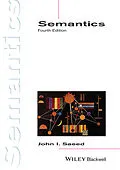Revised and updated to reflect recent theoretical developments in the field, Semantics, 4th Edition, presents an engaging and accessible introduction to the study of meaning in language for students new to the field of semantics.
* Covers all of the basic concepts and methods of the field of semantics, as well as some of the most important contemporary lines of research
* Features a series of new exercises, along with their solutions, that are arranged by level of difficulty
* Addresses componential theory, formal semantics, and cognitive semantics, the three main current theoretical approaches to semantics
* Includes revisions and updates that reflect the most recent theoretical developments
Autorentext
John I. Saeed is a Fellow of Trinity College, University of Dublin, Ireland, where he is a professor of linguistics. He is the author of several books, including Irish Sign Language: A Cognitive Linguistic Approach (with Lorraine Leeson, 2012), and Somali (1999).
Zusammenfassung
Revised and updated to reflect recent theoretical developments in the field, Semantics, 4th Edition, presents an engaging and accessible introduction to the study of meaning in language for students new to the field of semantics.
- Covers all of the basic concepts and methods of the field of semantics, as well as some of the most important contemporary lines of research
- Features a series of new exercises, along with their solutions, that are arranged by level of difficulty
- Addresses componential theory, formal semantics, and cognitive semantics, the three main current theoretical approaches to semantics
- Includes revisions and updates that reflect the most recent theoretical developments
Inhalt
List of Figures and Tables xv
Preface xvii
Abbreviations and Symbols xix
Part I Preliminaries 1
1 Semantics in Linguistics 3
1.1 Introduction 3
1.2 Semantics and Semiotics 5
1.3 Three Challenges in Doing Semantics 5
1.4 Meeting the Challenges 7
1.5 Semantics in a Model of Grammar 8
1.5.1 Introduction 8
1.5.2 Word meaning and sentence meaning 9
1.6 Some Important Assumptions 10
1.6.1 Reference and sense 11
1.6.2 Utterances, sentences, and propositions 11
1.6.3 Literal and non-literal meaning 13
1.6.4 Semantics and pragmatics 15
1.7 Summary 17
Exercises 17
Further Reading 19
Notes 19
References 20
2 Meaning, Thought, and Reality 22
2.1 Introduction 22
2.2 Reference 24
2.2.1 Types of reference 24
2.2.2 Names 26
2.2.3 Nouns and noun phrases 27
2.3 Reference as a Theory of Meaning 29
2.4 Mental Representations 31
2.4.1 Introduction 31
2.4.2 Concepts 32
2.4.3 Necessary and sufficient conditions 33
2.4.4 Prototypes 34
2.4.5 Relations between concepts 36
2.4.6 Acquiring concepts 37
2.5 Words, Concepts, and Thinking 37
2.5.1 Linguistic relativity 38
2.5.2 The language of thought hypothesis 40
2.5.3 Thought and reality 41
2.6 Summary 42
Exercises 43
Further Reading 44
Notes 44
References 45
Part II Semantic Description 49
3 Word Meaning 51
3.1 Introduction 51
3.2 Words and Grammatical Categories 52
3.3 Words and Lexical Items 53
3.4 Problems with Pinning Down Word Meaning 56
3.5 Lexical Relations 59
3.5.1 Homonymy 60
3.5.2 Polysemy 60
3.5.3 Synonymy 61
3.5.4 Opposites (antonymy) 63
3.5.5 Hyponymy 65
3.5.6 Meronymy 66
3.5.7 Member–collection 67
3.5.8 Portion–mass 67
3.6 Derivational Relations 67
3.6.1 Causative verbs 68
3.6.2 Agentive nouns 68
3.7 Lexical Typology 69
3.7.1 Polysemy 70
3.7.2 Color terms 71
3.7.3 Core vocabulary 73
3.7.4 Universal lexemes 74
3.8 Summary 75
Exercises 76
Further Reading 78
Notes 79
References 80
4 Sentence Relations and Truth 84
4.1 Introduction 84
4.2 Logic and Truth 86
4.3 Necessary Truth, A Priori Truth, and Analyticity 91
4.4 Entailment 94
4.5 Presupposition 97
4.5.1 Introduction 97
4.5.2 Two approaches to presupposition 98
4.5.3 Presupposition failure 100
4.5.4 Presupposition triggers 101
4.5.5 Presuppositions and context 103
4.5.6 Pragmatic theories of presupposition 104
4.6 Summary 105
Exercises 106
Further Reading 108
Notes 108
References 110
5 Sentence Semantics 1: Situations 112
5.1 Introduction 112
5.2 Classifying Situations 113
5.2.1 Introduction 113
5.2.2 Verbs and situation types 115
5.2.3 A system of situation types 118
5.2.4 Tests for situation types 120
5.2.5 Tense 122
5.2.6 Aspect 125
5.2.7 Comparing aspect across languages 130
5.2.8 Combining situation type and aspect 132
5.3 Modality and Evidentiality 134
5.3.1 Modality 134
5.3.2 Mood 138
5.3.3 Evidentiality 140
5.4 Summary 142
Exercises 143
Further Reading 146
No...
